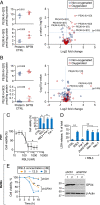PLA2G6 guards placental trophoblasts against ferroptotic injury
- PMID: 33087576
- PMCID: PMC7959495
- DOI: 10.1073/pnas.2009201117
PLA2G6 guards placental trophoblasts against ferroptotic injury
Abstract
The recently identified ferroptotic cell death is characterized by excessive accumulation of hydroperoxy-arachidonoyl (C20:4)- or adrenoyl (C22:4)- phosphatidylethanolamine (Hp-PE). The selenium-dependent glutathione peroxidase 4 (GPX4) inhibits ferroptosis, converting unstable ferroptotic lipid hydroperoxides to nontoxic lipid alcohols in a tissue-specific manner. While placental oxidative stress and lipotoxicity are hallmarks of placental dysfunction, the possible role of ferroptosis in placental dysfunction is largely unknown. We found that spontaneous preterm birth is associated with ferroptosis and that inhibition of GPX4 causes ferroptotic injury in primary human trophoblasts and during mouse pregnancy. Importantly, we uncovered a role for the phospholipase PLA2G6 (PNPLA9, iPLA2beta), known to metabolize Hp-PE to lyso-PE and oxidized fatty acid, in mitigating ferroptosis induced by GPX4 inhibition in vitro or by hypoxia/reoxygenation injury in vivo. Together, we identified ferroptosis signaling in the human and mouse placenta, established a role for PLA2G6 in attenuating trophoblastic ferroptosis, and provided mechanistic insights into the ill-defined placental lipotoxicity that may inspire PLA2G6-targeted therapeutic strategies.
Keywords: GPX4; PLA2G6; ferroptosis; placenta; trophoblast.
Conflict of interest statement
Competing interest statement: Y.S. is a consultant to Illumina, Inc.
Figures





References
Publication types
MeSH terms
Substances
Grants and funding
LinkOut - more resources
Full Text Sources
Other Literature Sources
Molecular Biology Databases
Research Materials
Miscellaneous

